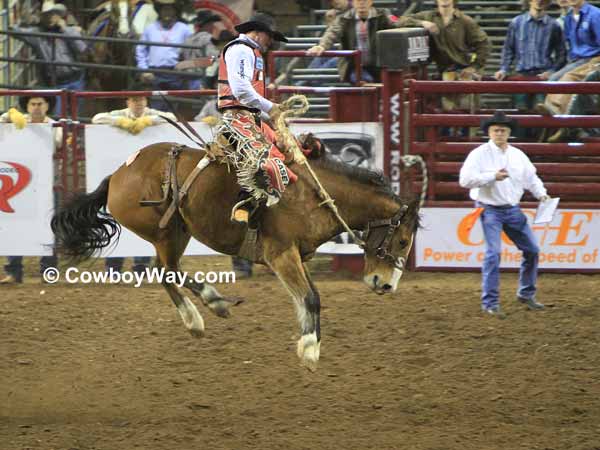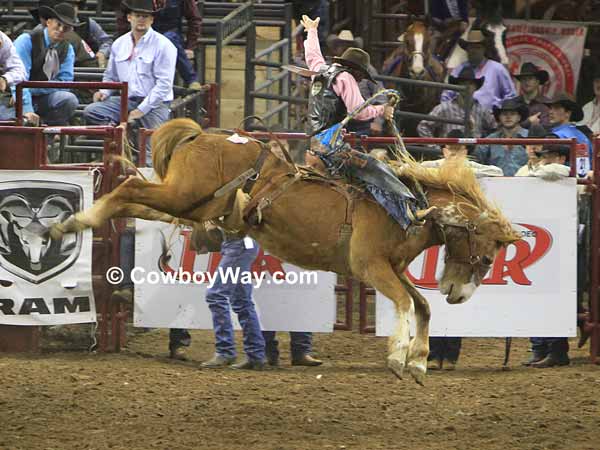Saddle Bronc Riding Pictures - Page 1 of 3
Saddle bronc riding is a rodeo event in which a rider tries to ride a saddled bucking horse for eight seconds.
If the rider makes a qualified ride he will receive a score for his riding skills and the horse will receive a score for its bucking skills. The two scores are added together to arrive at a total score for the ride. The highest total score determines the winner.
Please scroll down below the pictures for more information on saddle bronc riding. You might also like: Bronc halters for sale (for saddle horses, not broncs).
All photos are copyrighted © and property of CowboyWay.com



You might like these items. Or, Photos continues below.





All photos are copyrighted © and property of CowboyWay.com
Saddle Bronc Riding Vs. Bareback Bronc Riding
In a "regular" rodeo there are two types of bronc riding: Saddle bronc riding and bareback bronc riding. Below is a description of some of the differences between the two events.
- In saddle bronc riding contestants ride the horse (the "bronc") with a
saddle and a halter with a rein.
- A saddle for saddle bronc riding is made especially for the event. It is lighter weight than many other Western-style saddles, does not have a saddle horn, and the stirrup leathers allow for far more freedom in the rider's leg movements than a typical Western saddle.
- The halter worn by the bronc is called a "bronc halter." It has a long, thick, rein called a "hack rein." The rider holds the hack rein with one hand while the other hand, the "free hand" is not allowed to touch the rider, the bronc, the saddle, or the hack rein.
- In bareback bronc riding the contestants ride the bronc bareback with a
"bareback rigging." They do not use a halter or hack rein.
- A "bareback rigging," is a special piece of equipment designed for bareback bronc riding. The bareback rigging goes around the bronc's girth and has a handhold at the top. Contestants sit behind the bareback rigging and ride the bronc bareback, holding on with one hand in the handhold of the rigging. The other hand, the "free hand," is not allowed to touch the rider, the bronc, or the bareback rigging. You can see photos of bareback bronc riding here.
Note: There is also a type of bronc riding known as ranch bronc riding. Ranch bronc riding is associated with ranch rodeo, a type of rodeo where contestants compete in teams from ranches instead of as individuals as in a "regular" rodeo. We have photos and more information about ranch bronc riding here.
Scoring Saddle Bronc Riding
- If a saddle bronc rider makes a qualified ride on a bronc for eight seconds he and the bronc are eligible to receive a score from the judges.
- There are two judges. At the end of a qualified ride their scores are added together to arrive at the total score.
- Each judge scores the bronc rider from 1–25 points.
- Each judge scores the bronc from 1–25 points.
- Since there are two judges, and each judge can award a possible 50 points (25 for the bronc rider plus 25 for the bronc), the total number of possible total points that can be awarded is 100.
Bareback bronc riding uses the same method of scoring.
The Mark Out Rule
Both saddle bronc riding and bareback bronc riding have a rule called the "mark out" rule. The mark out rule requires the rider to have the rowels of both spurs in front of, and touching, the break of the bronc's shoulders on its first move out of the chute. The rider's feet must still be in this position when the bronc's front feet hit the ground for the first time. This is called "marking a horse out." If a bronc rider fails to mark a horse out with one or both feet they will receive a no score. The mark out rule is also called the "spur out" rule.
Under certain circumstances the mark out rule may be waived. For example, if a bronc stalls in the chute the judge may tell the rider they can "go on" or "go to the belly." This means the bronc rider can take his feet to the sides of the horse for the first jump out of the chute instead of having them over the points of the horse's shoulders. Being allowed to go to the belly waives the mark out rule for that one ride. For more information on the mark out rule, see this page: The markout rule.
